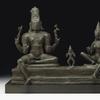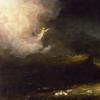Kees Van Dongen at the Musée d’Art Moderne
- April 02, 2011 14:53
For four months, the Musée d’Art Moderne de la Ville de Paris offers to rediscover Kees Van Dongen, the complex Dutch artist who became in the 1920s an essential figure of the Fauvism, a caricaturist of the times and a Parisian socialite, but was later boycotted in France due to his highly controversial association with the German Reich.
Kees Van Dongen was born in 1877, near Rotterdam, in a wealthy family. He enters the Royal Academy for the Arts at the age of sixteen. For the following years, he study drawing. His artwork will represent the world of sailors and prostitutes, characteristic of Rotterdam harbor.
In 1897, he moves to Paris for a few months and returns two years later to join Augusta Preitinger, a young woman he had met at the Academy. They will get married in 1901. Soon, Van Dongen starts to exhibit his artwork in Paris. Friends with Toulouse Lautrec and Steinlen, his work is inspired by social injustice and hardship observed in the street with an acute eye. Until 1905, he realizes three hundred drawings for L’Assiette au Beurre, a socially oriented newspaper. At the same time, his interest shifts toward painting and the pleasures of life.
In the fall 1904, his paintings are noticed at the Salon des Independants. His landscapes, marines and views of Paris enter the Galerie Vollard. He meets Matisse during a trip to Normandy and adds more brilliance and boldness to his palette. His participation to the controversial Salon d’Automne exhibit in 1905 signs his association to the Fauvist movement. Influenced by Van Gogh, he focuses his studies around color, shapes and soon his name incarnates modernism and audacity. In 1910, Van Dongen journeys to Spain, Italy and Morocco. He returns to Paris with a new palette influenced by warmth, bold colors, silky fabrics, nuances of whites and the color red that will play a major role in his future work.
Success allows Van Dongen a pleasant lifestyle and he is, from 1920 to 1930, the portraitist of the Parisian high society. A retrospective exhibit in 1927 at the Stedelijk in Amsterdam gives him international recognition.
In 1929, Kees Van Dongen becomes a French citizen but his reputation is tarnished when in October 1941, he participates with seven French writers to a political journey organized by Joseph Goebbels, the German minister of the propaganda for the Reich.
Van Dongen settles in Monaco where he will die in 1968. Although many retrospectives and exhibits honor his work abroad, France boycotts him until 1959, when his participation to an exhibit about the French Fauvism and the beginnings of Impressionism somehow helps restore his reputation.
Has the time come to rediscover one of the most complex artists of the early 20th century? This is what the Van Dongen Exhibit offers from March 25 to July 17 at the Musée d’Art Moderne de la Ville de Paris.


_d5408905h270x400_c.jpg)


















